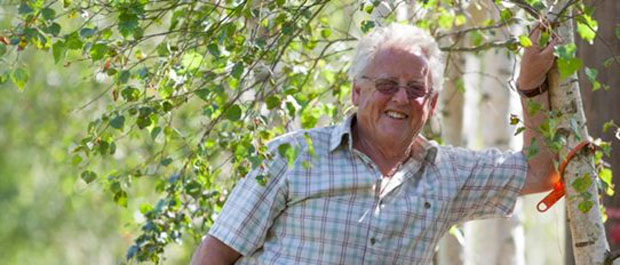
For the past 50 years, Hillier plant expert, Ricky Dorlay, has prepared the plant material for the Hillier Chelsea exhibit. This would be tricky enough for just one species, but Ricky’s challenge is to personally manage the growing season of over 200 trees and plants – from birch trees, flowering cherries to scented garden roses, flowering cornus, agapanthus, astelias, viburnums, foxgloves and plenty more besides. Each demands specific, different and optimal heat, light and growing conditions to reach their peak in time for Chelsea.
With 49 RHS Chelsea Gold medals for Hillier to his credit, you might consider that he has mastered the art of controlling nature, but Ricky is more circumspect: “Mother Nature holds all the cards and every season is different,” he says. For decades, Ricky has kept detailed notes of his Chelsea preparations in the vain hope that they might help inform his decisions in future years. Instead, it is still the weather forecasts that rule Ricky’s life from early March to the third week in May.
Ricky, now 74, has learnt to judge when a variety needs to be held back and when it needs moving on. Timing is everything. Japanese maples and selected evergreens are brought into the Chelsea glasshouse in November to protect them from the worst of the winter weather. Flowering cherries go into the cold store as early as January and don’t emerge until early May. Roses, rhododendrons and hostas are moved under glass in early March as they start to bud up. Ricky patrols his stock 7 days a week, moving plants to the warmer polytunnels to move them on, or into the glasshouse or the cold store to hold them back.
As he prepares for his 50th Chelsea, Ricky is as focused as ever. “The acers are looking really good this year as is Calycalycanthus ‘Hartlage Wine’ and, one of my favourites, Cornus controversa ‘Variegata’. My ambition is to get that 70th Chelsea Gold medal for Hillier,” says Ricky. “That would really be something, wouldn’t it?”
Ricky’s Year
November: Protection under glass
Ricky’s Chelsea preparations start as early as November. Ricky selects those plants from Hillier’s dedicated Chelsea stock, which will benefit from protection over winter under glass. Plants, such as the Japanese maples and certain evergreen varieties susceptible to harsh winter frosts are taken into the Chelsea greenhouse at the Braishfield site.
January: Flowering Cherries
As early as January, Ricky moves the flowering cherries into the cold store when they are very dormant “to go to sleep”. He won’t “wake them up” until early May otherwise they will flower too early for Chelsea.
This April, a 10-hour power cut to the cold store was enough for some flowering cherries to emerge from dormancy and burst into flower as the temperature rose out of control.
DID YOU KNOW? Sir Harold Hillier pioneered the technique of cold-storing cherry trees back in the 1920s. He had the idea of storing the flowering cherries in the vast refrigerated meat stores at Southampton Docks. When the trees made their spectacular appearance in full bloom at Chelsea, they caused a sensation as a dramatic Chelsea first.
Early March to mid-May:
All is then quiet until the end of February to early March when the “stock starts to move”, that is when the plants start to come out of their winter dormancy and into leaf. From then until the show itself, Ricky constantly has one eye on the weather reports.
He has to assess the effects of weather and temperature on not just one type of flower but on over 200 different varieties of plant and trees. If a variety is a little slow to develop, it is moved from the glasshouse to the polytunnels. If it’s going to fast, it is moved to the glasshouse or perhaps to the coldstore.